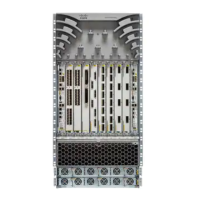PurposeCommand or Action
Specifies a syslog server host as a destination for syslog messages. IPv4
and IPv6 are supported.
logging {ip-address | hostname}
Example:
RP/0/RSP0/CPU0:router(config)# logging
10.3.32.154
Step 2
•
By issuing this command more than once, you build a list of syslog
servers that receive logging messages.
Limits the syslog messages sent to syslog servers based on severity.
logging trap [severity]
Step 3
Example:
RP/0/RSP0/CPU0:router(config)# logging
trap
•
By default, entering this command without specifying a severity
level for the severity argument sets the severity level to
informational.
(Optional) Configures syslog facilities.
logging facility [type]
Step 4
Example:
RP/0/RSP0/CPU0:router(config)# logging
facility kern
•
By default, entering this command without specifying a facility
type for the type argument sets the facility to local-7.
(Optional) Appends a hostname prefix to syslog messages being sent
from the router to syslog servers.
logging hostnameprefix hostname
Example:
RP/0/RSP0/CPU0:router(config)# logging
hostnameprefix 123.12.35.7
Step 5
Hostname prefix logging can be useful for sorting syslog
messages received by syslog servers.
Tip
(Optional) Sets the syslog source address.
logging source-interface type
interface-path-id
Step 6
•
By default, a syslog message sent to a syslog server contains the
IP address (IPv4 and IPv6 are supported) of the interface it uses
to leave the router.
Example:
RP/0/RSP0/CPU0:router(config)# logging
source-interface HundredGigE 0/1/0/0
•
Use this command to set all syslog messages being sent from the
router to contain the same IP address, regardless of which interface
the syslog message uses to exit the router.
commit
Step 7
Configuring the Settings for the Logging History Table
This task explains how to configure the settings for the logging history table.
For conceptual information, see the Severity Levels, on page 292 section.
Before You Begin
Logging of messages to an SNMP NMS is enabled by the snmp-server enable traps syslog command. For
more information about SNMP, see the Related Documents, on page 308 section.
Cisco ASR 9000 Series Aggregation Services Router System Monitoring Configuration Guide, Release 4.2.x
297
Implementing Logging Services
Configuring the Settings for the Logging History Table

